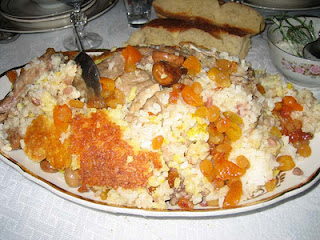I kept everything small and casual - 2 simple appetizers, plov (the famous rice dish), and 2 other main dishes. My friend Linda brought some baklava for dessert. Linda and her friend Jane were kind enough to come early and help prepare.
The Appetizers:
http://www.azcookbook.com/olive-walnut-pomegranate-medley-zeytun-perverde/
http://www.news.az/recipes/27251 (Eggplant with tomato and garlic)
Now I just needed something resembling Azerbaijani "tandoor" bread to serve with it. After researching pictures and descriptions on the internet I decided that a selection of breads from a neighborhood Indian restaurant would work.
As second appetizer/side dish I chose an eggplant, tomato and garlic combination. The recipes calls for salting the eggplant slices and letting them sit for several hours to draw out any bitterness. One tip: go light on the salt because the eggplant will soak up more than you think. Also, you might try baking the eggplant slices with olive oil instead of frying to save time.
Plov:
http://www.azcookbook.com/layered-rice-pilaff-with-dried-fruits-chestnuts-parcha-dosheme-plov/
Other Main Dishes:
http://www.azcookbook.com/braised-lamb-with-pomegranates-and-chestnuts/http://www.azcookbook.com/fish-bughlama/
For the lamb dish the most difficult part was extracting the pomegranate seeds or "arils." Jane was incredibly patient dealing with those pomegranates! Keep in mind that you can always spend a little extra money to buy the seeds already peeled. The most important part of the dish is sauteing the onions with the meat until they are a deep golden brown, letting the flavors develop.
The lemony fish with vegetables and herbs was simple and delicious and also very healthy. Linda and Jane said the dish reminded them of Chinese-style steamed fish.
Finally, here are a few extra pics of the girls finishing preparations:
























